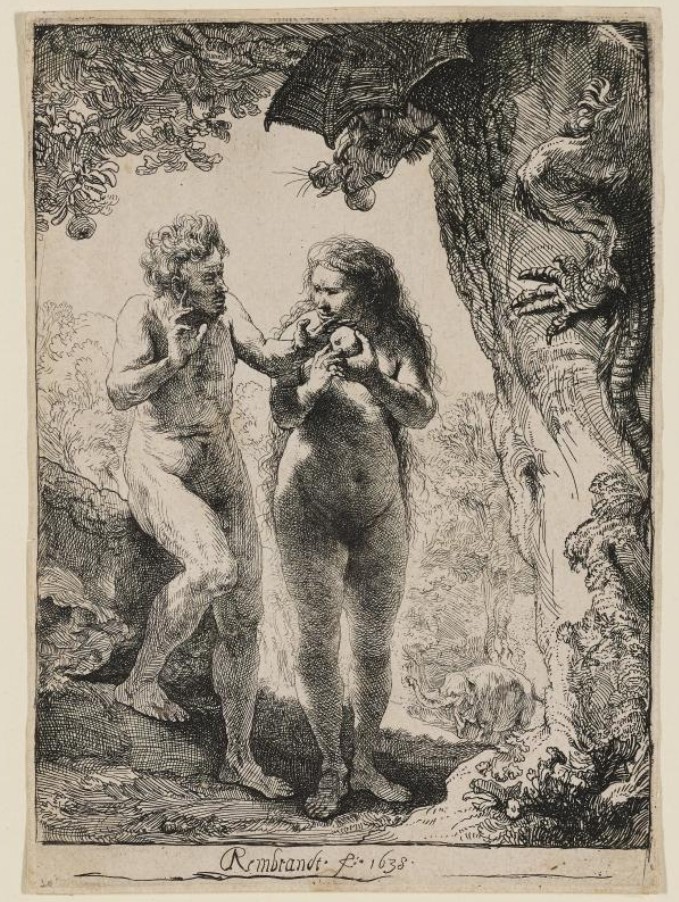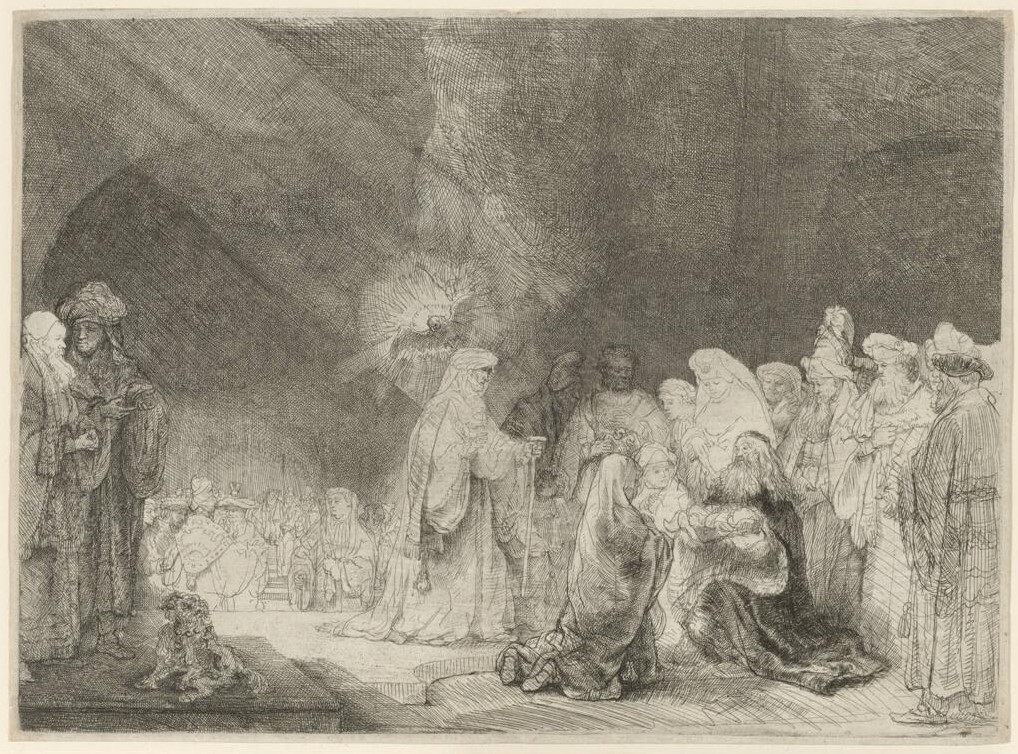
In s2e20, Ann Shafer and Tru Ludwig conclude their discussion of Rembrandt van Rijn, the man who made etching was it is today and humanized biblical figures.
In s2e20, Ann Shafer and Tru Ludwig conclude their discussion of Rembrandt van Rijn, the man who made etching was it is today. In this third of three episodes on Rembrandt, they tackle his etchings of religious scenes. Rembrandt made a lot of them and they are intense. They are special because Rembrandt humanizes the people in them, which really hadn't happened before. It's almost as if viewers can find themselves in the scenes. Biblical stories are brought to life under Rembrandt sure hand.
Rembrandt (Dutch, 1606–1669). Christ Before Pilate (the large plate), 1636. Etching. Sheet (trimmed to platemark): 21 3/4 x 17 5/8 in. (553 x 448 mm.). Metropolitan Museum of Art, New York.
Rembrandt (Dutch, 1606–1669). Adam and Eve, 1638. Etching. Sheet (trimmed to platemark): 6 7/16 x 4 5/8 in. (16.3 x 11.7 cm.). Minneapolis Institute of Arts, Minneapolis.
Rembrandt (Dutch, 1606–1669). Presentation in the Temple, c. 1640. Etching and drypoint. Sheet: 218 × 296 mm. (8 9/16 × 11 5/8 in.); plate: 213 × 290 mm. (8 3/8 × 11 7/16 in.). Baltimore Museum of Art, Baltimore.
[DETAIL] Rembrandt (Dutch, 1606–1669). Presentation in the Temple, c. 1640. Etching and drypoint. Sheet: 218 × 296 mm. (8 9/16 × 11 5/8 in.); plate: 213 × 290 mm. (8 3/8 × 11 7/16 in.). Baltimore Museum of Art, Baltimore.
Rembrandt (Dutch, 1606–1669). Death of the Virgin, 1639. Etching and drypoint. Sheet: 413 × 317 mm. (16 1/4 × 12 1/2 in.); plate: 409 × 315 mm. (16 1/8 × 12 3/8 in.). Baltimore Museum of Art, Baltimore.
Rembrandt (Dutch, 1606–1669). Sheet of Studies with a Woman Lying Ill in Bed, c. 1641/42. Etching. Sheet (trimmed to platemark): 139 x 152 mm. Metropolitan Museum of Art, New York.
Martin Schongauer (German, 1435/50–1491). Death of the Virgin, c. 1455-91. Engraving. Sheet (trimmed to platemark): 10 1/16 × 6 5/8 in. (25.5 × 16.8 cm.). Metropolitan Museum of Art, New York.
Rembrandt (Dutch, 1606–1669). St. Jerome in a Dark Chamber, 1642. Etching, engraving, and drypoint. Sheet (trimmed to platemark): 6 × 6 15/16 in. (15.3 × 17.6 cm.). Metropolitan Museum of Art, New York.
Rembrandt (Dutch, 1606–1669). St. Jerome in a Dark Chamber, 1642. Etching, engraving, and drypoint. Sheet (trimmed to platemark): 5 7/8 x 6 ¾ in. (15.1 × 17.3 cm.). Sotheby’s, London.
Rembrandt (Dutch, 1606–1669). St. Jerome in a Dark Chamber, 1642. Etching, engraving, and drypoint. Sheet (trimmed to platemark): 5 7/8 x 6 7/8 in. (15.1 × 17.5 cm.). Baltimore Museum of Art, Baltimore.
Rembrandt (Dutch, 1606–1669). St. Jerome in a Dark Chamber, 1642. Etching, engraving, and drypoint. Sheet (trimmed to platemark): 5 7/8 x 6 3/4 in. (15.1 × 17.3 cm.). Bonham’s New York.
Rembrandt (Dutch, 1606–1669). The Hundred Guilder Print: Christ with the Sick around Him, c. 1648. Etching, drypoint, and engraving on Japanese paper. 280 x 394 mm. Rijksmuseum, Amsterdam.
Rembrandt (Dutch, 1606–1669). Abraham Caressing Isaac, c. 1637. Etching and drypoint. 116 x 89 mm. Victoria and Albert Museum, London.
Rembrandt (Dutch, 1606–1669). Abraham and Isaac, c. 1645. Etching and engraving. 155 x 128 mm. Victoria and Albert Museum, London.
Rembrandt (Dutch, 1606–1669). Abraham’s Sacrifice, 1655. Etching and drypoint. Sheet (trimmed to platemark): 6 5/16 × 5 1/4 in. (161 × 134 mm.). Metropolitan Museum of Art, New York.
Rembrandt (Dutch, 1606–1669). Christ Presented to the People: Ecce Homo (state ii/viii), 1655. Drypoint. Plate: 15 1/8 x 17 5/8 in. (384 x 448 mm.); sheet: 15 3/8 x 17 7/8 in. (391 x 454 mm.). St. Louis Art Museum, St. Louis.

Rembrandt (Dutch, 1606–1669). Christ Presented to the People: Ecce Homo (state viii/viii), 1655. Drypoint. Sheet (trimmed to platemark): 14 x 17 15/16 in. (356 x 455 mm.). Metropolitan Museum of Art, New York.
Lucas van Leyden (Netherlandish, c. 1494–1533). Ecce Homo, 1510. Engraving. Sheet: 11 3/8 x 17 15/16 in. (289 x 456 mm.). Metropolitan Museum of Art, New York.
Rembrandt (Dutch, 1606–1669). Christ Crucified between the Two Thieves: The Three Crosses (i/iv state), 1653. Drypoint on vellum. Plate: 15 x 17 1/4 in. (381 x 438 mm.); sheet: 15 1/8 x 17 7/16 in. (384 x 443 mm.). Metropolitan Museum of Art, New York.
Rembrandt (Dutch, 1606–1669). Christ Crucified between the Two Thieves: The Three Crosses (iv/iv state), c. 1660. Drypoint. Sheet (trimmed to platemark): 15 1/16 x 17 1/2 in. (382 x 444 mm.). Metropolitan Museum of Art, New York.
Rembrandt (Dutch, 1606–1669). Christ Crucified between the Two Thieves: The Three Crosses (iii/iv state), c. 1660. Drypoint. Sheet: 15 5/16 × 17 15/16 in. (389 × 456 mm.); plate: 15 3/16 × 17 7/8 in. (385 × 454 mm.). Metropolitan Museum of Art, New York.
Rembrandt (Dutch, 1606–1669). Christ Crucified between the Two Thieves: The Three Crosses (iv/iv state), c. 1660. Drypoint. Sheet (trimmed to platemark): 385 x 451 mm. British Museum, London.
Rembrandt (Dutch, 1606–1669). Saint Jerome Kneeling in Prayer, Looking Down, 1635. Etched copper plate. 116 x 82 mm. (4 9/16 x 3 ¼ in.). Baltimore Museum of Art, Baltimore.
Rembrandt (Dutch, 1606–1669). Saint Jerome Kneeling in Prayer, Looking Down, 1635. Etching. Sheet (trimmed to platemark): 115 x 82 mm. (4 1/2 x 3 ¼ in.). Baltimore Museum of Art, Baltimore.
Rembrandt (Dutch, 1606–1669) and William Baillie (Irish, 1723–1810). The Hundred Guilder Print: the central part with Christ Preaching, the plate arched, c. 1648 and 1775–1800. Etching and drypoint. 280 x 190 mm. Rijksmuseum, Amsterdam.
Platemark is produced by Ann Shafer
Theme music: Michael Diamond
Audio mixing: Dan Fury, Extension Audio
PR and Marketing: Elizabeth Berger, EYB Creates






























